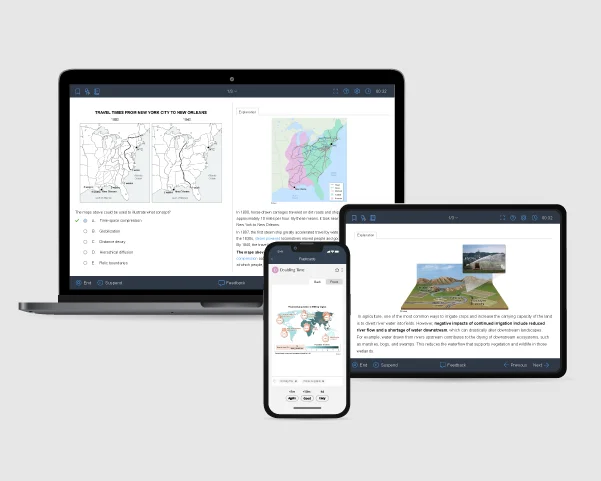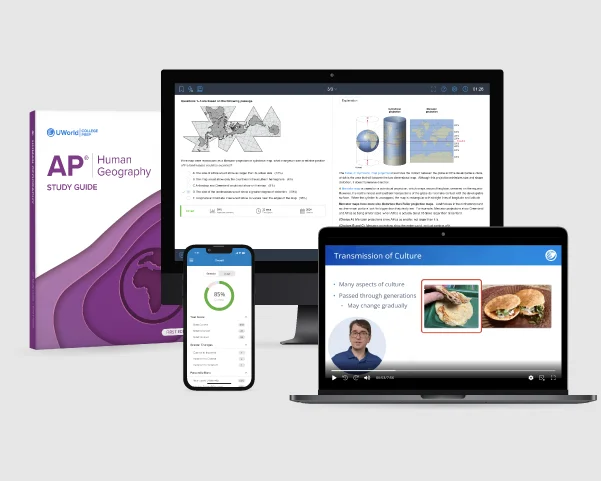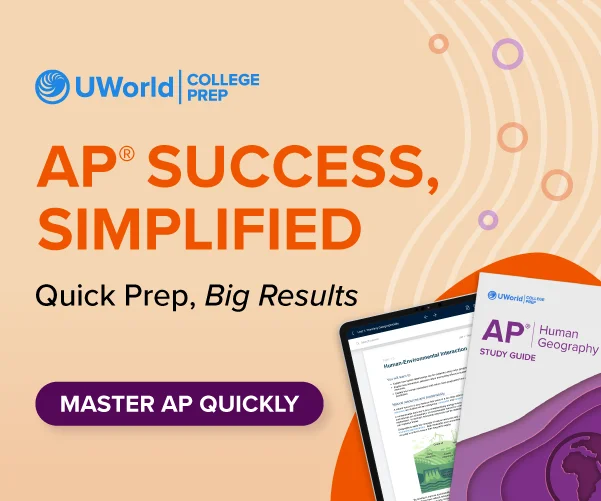Format of the AP Human Geography MCQ section
The multiple choice section of the AP Human Geography exam includes 60 questions. Each question has five possible answers, with only one correct answer. All units are assessed in the MCQ section, with slightly fewer questions coming from unit one. Some questions are based on a stimulus like data, maps, or graphics. Some questions are stand-alone questions, and others are set-based questions.
How to Approach AP Human Geography Multiple-Choice Questions
For many students, the AP Human Geography MCQ section can be the most difficult because there are a total of 60 questions and only 60 minutes to answer all of them. That’s just one question a minute! 30-40% of the questions include a stimulus (map, graph, table, etc.). It can be a challenge to understand the stimuli and select the correct answers in that amount of time. Here are some pointers to help you prepare for the difficulty of the questions and work quickly.
Read the question first.
Because of the limited time available to answer the AP Human Geography multiple-choice questions, you cannot afford to lose time trying to understand everything about the stimulus (if one is present). Instead, read the question and then dig through the stimulus for the information that will help you choose the correct answer. The question will provide context in which to interpret the stimulus and make it easier to locate relevant information quickly.
-
All parts of an answer must be accurate for the answer to be correct; partly right isn't close enough.
Sometimes students are duped into thinking an answer is correct because part of the answer choice is right. However, the rest of the answer may contain incorrect information, rendering the entire answer incorrect. For example, eliminate answers that contain inconsistencies in data or are unrelated to the theory defined by the question. If you are unable to determine the correct answer, concentrate on determining what makes each answer choice incorrect. Eliminating obviously incorrect answers will help you narrow your options and, if necessary, make a better guess.
-
Answer every question.
There is no penalty on the exam for incorrect answers, so you should always take your best guess because the odds are better if you record an answer for every question.
AP Human Geography Multiple Choice Examples
Here are some sample AP Human Geography multiple-choice questions.
| Region | Population in 2021 |
Yearly Percent of Growth |
|---|---|---|
| Africa | 1.3 billion | 2.49 |
| Asia | 4.6 billion | 0.86 |
| Europe | 748 million | 0.06 |
| Latin America and the Caribbean | 654 million | 0.9 |
| Northern America | 369 million | 0.62 |
| Oceania | 42 million | 1.31 |
| Source: United Nations Population Division. | ||
- Africa
- Europe
- Latin America and the Caribbean
- Northern America
- Oceania
MCQ Example 3
The boundary between the United States and Canada, which was finalized in 1846 after decades of dispute, is considered a geometric boundary. Which of the following characteristics applies to this term?- The boundary was established along existing ethnic boundaries
- The boundary was established along the 49th parallel
- The boundary was established along religious lines
- The boundary was established by Native American tribes
- The boundary was established following natural land formations

How can I Practice AP Human Geography Multiple-Choice Questions?
One of the best ways to improve your AP Human Geography MCQ score is to practice by answering a lot of questions. This allows you to become familiar with commonly-assessed information as well as how questions are worded. It’s a good idea to practice answering MCQs at your own pace, at least initially, so you can think about each answer carefully. After you have developed your confidence and skills, you should start answering practice questions at the same pace as on the exam: about one minute per question.
Now that you know everything about how to approach this section, it’s time to start your AP Human Geography MCQ practice. UWorld’s AP Human Geography prep course, which comes with a comprehensive study guide and an extensive QBank, is an excellent resource with over 500 questions written very similarly to those found on the actual exam. UWorld provides explanations to help you understand why one answer is correct and others are incorrect. Knowing how to determine where you may have erred while answering a question helps you avoid making the same mistake in the future.
Frequently Asked Questions
How many multiple-choice questions are there in AP Human Geography?
How are AP Human Geography multiple-choice questions graded?
How long is the AP Human Geography exam multiple-choice?
When can I get the AP Human Geography past exam multiple-choice questions?

References
- AP Human Geography: About the Course. (2024) apcentral.collegeboard.org. Retrieved December 12, 2024, from https://apcentral.collegeboard.org/courses/ap-human-geography/exam
- AP Human Geography Course and Exam Description. (Fall 2020). apcentral.collegeboard.org. Retrieved December 12, 2024, from https://apcentral.collegeboard.org/media/pdf/ap-human-geography-course-and-exam-description.pdf
Related Topics
How to Answer AP Human Geography FRQs
It's easy to become overwhelmed when it comes to Free Response Questions. Check out our expert advice on answering the AP Human Geography FRQ section effectively.
How to Study for AP Human Geography
Are you looking for five-star exam-winning strategies for AP HUG? Check out our AP Human Geo study guide, prepared by experts, with all the tips to score a 5 easily.
The AP HUG exam is approaching, and you're wondering if you'll do well! We've got you covered with our AP Human Geography exam guide, providing all the info you need.
Best AP Human Geo Study Guide Comparison
Kaplan vs. Barron's vs. Princeton Review vs. UWorld—compare strategies, features, and effectiveness to find the ultimate guide for AP Human Geo success.
Best AP Human Geo Prep Course Review
Discover the best AP HUG prep courses available. Compare key features, pricings, reviews, and benefits to select the course that best fits your learning.
How to Self-Study for AP Human Geo
Want to ace AP Human Geo on your own? Follow this expert self-study guide with tips, tricks, and tools to prepare effectively for the exam.





